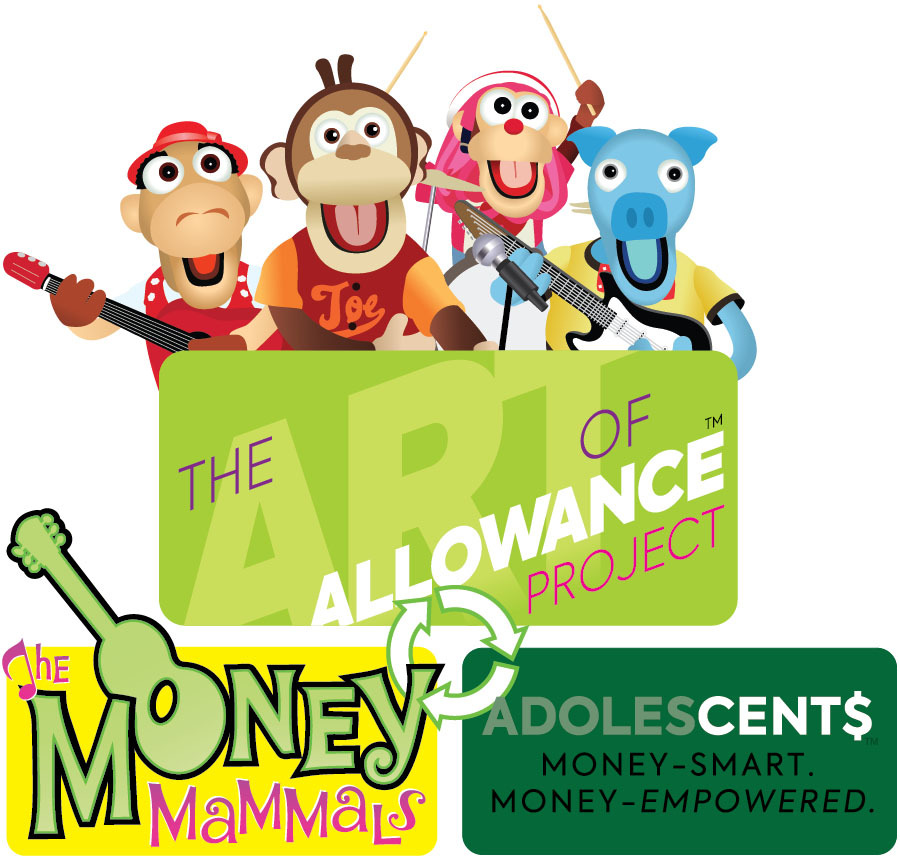
“Working to help parents raise money-smart kids.”
Hello, friends!
I hope you’re enjoying a reflective and relaxing Indigenous Peoples’ Day.
If you have today off, then I don’t want to take up too much of your time. So let’s get into this week’s “3 Ideas to Share & Save”!
— 1 —
The “Cycle” of (Financial) Life: Since we recently updated our logo, I want to explain the seemingly minor, yet important, change.
Last year, we made a fairly major upgrade to our offerings when we incorporated all the loosely connected elements of what we do into one cohesive program to help families raise money-smart kids.
What began with The Money Mammals and their mantra, “We’ll Share & Save & Spend Smart Too,” had grown in scope. Joe the Monkey and his pals Clara J. Camel, Piggs the Bank and Marmoset the Monkey were still at the core of our belief that the money-smart journey starts at a very young age. But our original logo, pictured below, didn’t quite cover our more comprehensive message.

So taking a page from my book, The Art of Allowance, which I wrote to help parents raise money-smart kids, we launched the more extensive Art of Allowance Project featuring our good friends, The Money Mammals, and a new portal for tweens and teens, Adolescent$.
Like its pyramid logo above, this new program underscores the importance parents play in the journey of raising money-smart kids. We also added a long-requested component, content for tweens and teens, as kids aging out of The Money Mammals were looking for age-appropriate resources, like our Adolescent$ portal’s “Good Money Habits” videos:
And with our nationwide credit union partners, the goal is to help create generational members: money-smart families whose kids learn through the program, become money-empowered and begin the cycle again with their own children. You can read more about how that process works here.
Although this new logo communicated our broader program, I realized The Money Mammals’ smiling faces were missing. We didn’t want to lose the fun that we originally brought to a topic that most kids would otherwise find boring.
Which brings us to our new logo! In addition to the obvious reintroduction of our mammal friends, we included a subtle cycle graphic to underscore our program’s potential to impact generations. What do you think?

— 2 —
Can we keep it short?: For those of you whose eyes are glazing over after all this talk of program changes and logos, perhaps you’d like the TL;DR version of what we’re all about.
So here’s my #FridayIntroductions Instagram post from last week:
Please follow both my account and our corporate account to keep up with all things Art of Allowance Project.
— 3 —
Your Apprentices: During our money-smart journeys, it might be helpful to think of our kids as apprentices. On that note, writer David Perell’s recent essay on education inspired me. Here’s an excerpt:
“Improving creative education begins with retrieving the benefits of apprenticeships. When you imitate somebody’s work, you’re forced to think about why they made the decisions they made. Through consumption and creation, you weave the threads of other people’s work into a tapestry of your own.”
As I mentioned in my latest essay, which I first shared with you in September, parental modeling of money-smart behaviors is one of the three key components of financial socialization. The other two elements are direct instruction (like they get in school) and experiential learning (like they get from an allowance).
When I studied art in school, I remember copying the Cézanne painting below. Doing so was a form of apprenticeship to both my instructor and the artist himself.
My version paled in comparison, of course, but I did learn a lot about composition. My professor also worked with me to understand how Cézanne applied his paint in layers. So through this process, I discovered how much work goes into a copy, let alone the actual work itself.
And our kids love to copy what we do. (Even traits we’d prefer they not adopt, like sarcasm.)
Case in point: When I picked up my daughter from school years ago, I told her we were going to The Home Depot. Then yours truly promptly forgot to stop. So when we arrived at our house, she wasn’t in her normal hurry to get out of the car. She looked at our destination, glanced back at me in the rear-view mirror and asked, “Is this The Home Depot?”
I think we can all agree that it’s better to put our little apprentices to work copying more valuable traits.
So when we begin an allowance program, we introduce three jars because we want our kids to learn about making money choices: saving for longer-term items, sharing or charitable giving and, of course, spending smart.
And before they start driving, our kids notice us searching around for gas stations with the best prices. We can only hope they will copy our behavior when they have their own set of wheels.
At times we may not feel like experts. But our kids are our apprentices, so they are learning. And like any expert/apprentice relationship, in time the apprentices will show us the way, like when my daughter introduced my wife and me to the GasBuddy app.
So let’s try to enjoy the journey with our apprentices together.
John, Chief Mammal
P.S. Please consult with a financial or investment professional before engaging in any decisions that might affect your own financial well-being.
Like what you just read? You can sign up for the newsletter here.
